|
By Paul Richmond - Port Orchard, Washington - USA
Richmond Boat Shop
|
|
|
Hello! My name is Paul Richmond. I am the eldest son of Jess Richmond, a boat builder and commercial fisherman who learned his building trade in the Bremerton Naval Shipyard prior to WWII. He started the apprenticeship program when he was just 17 and, I believe, even before he finished high school.
Apprenticeship training in that era was ‘the real thing’. The young men were rotated through every phase of design, lofting, procurement, as well as the actual hand skills necessary to build something. They also built a number of their hand planes and other tools as part of the process. He worked on everything from small captain’s gigs up through wooden mine sweepers. (I think they were somewhere around 290’ or so.) All of his construction experience was in wood but there was some work in fiberglass as well.
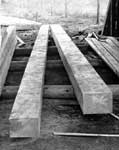
Endeavor Keel Sticks |
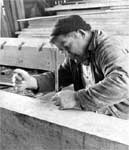
Dad working on keel |
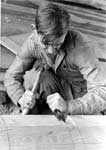
Dan cutting frame pockets |
After WWII my father returned to the states on the Oregon coast and built a small fishing boat that he fished out of Port Orford, on the southern Oregon coast. After an engine failure, (ok he admitted he ran out of gas), he and one of my cousins drifted for two days and nights south through the St. Georges Reef in northern California and had the thrill of riding through the surf and loosing the boat. Somewhere about that time he moved back to his home in the Puget Sound area of Washington State. He went back to work at the shipyard after he and my mother were married and worked there up until I was about three or four I guess. Being a man of an independent disposition he didn’t really like working at the shipyard and decided to take up fishing again.
He purchased a surplus 25’ double ended pulling whaleboat from the navy and proceeded to rework it by adding a shaft log, engine, about 2’ additional freeboard, a cabin, fish hold and decks along with the equipment necessary to salmon trolling. He had a 6” skill saw, a ¼” electric drill, and some hand tools that he had acquired over the years. My earliest memories of my dad have him asking me to hand that skill saw up to him between frames that little pulling whaleboat. It was all I could do to lift it as I remember. Occasionally, I remember going to the boat yard with him where he would borrow the use of a planer and band saw.
When he left to go fishing that first season with the new boat, he had $5 and he left Mom with another $5, the total sum of their cash resources. He didn’t have any charts or even know for sure where he needed to go to get to Neah Bay on the northwest corner of the state where he intended to fish. The gurdies, (small winches used to manage the trolling gear), were on the back deck but they weren’t even hooked up and working yet. The boat’s name? The Folly. I guess Dad did have a sense of humor. It was just a little warped.

Folly unloading fish |
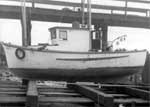
Folly |
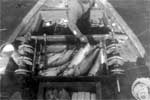
Folly working the gear |
In the following years Dad did a lot of repair work on boats during the winters and fished during the summers. A couple of lean winters he worked in Sagstead’s boat shop in Seattle, coming home on the bus over the weekends. They had a contract to build 12-13 commercial fishing boats for the Macaw Indians at Neah Bay in an effort to make them more self sufficient. Dad never really felt good about that project. He felt that the young men from the tribe should have been taken into an apprenticeship program and taught how to build their own boats but that wasn’t the way the program worked. Of the boats that were built, I don’t believe half of them survived 10 years due to neglect, poor maintenance, etc. It’s hard to care about something that comes too easy.
Enough ancient history, let’s jump forward to merely early history, when during my junior high years, we built our first of four ‘big’ boats based on a model my father designed. It was to be about 46’ long and was a ‘family project’. I, my two brothers, two sisters, and my mom all worked on it to get it ready to launch.
The project started a year or two earlier when my father purchased three old growth fir logs from the local plywood mill. I seem to remember the logs had problems with a split or something that rendered them useless for peeling into plywood but they made great saw logs. They ranged in length from 28 – 33 feet and the little one was 46” in diameter on the small end. The logs were sawn at the long since gone Carlsborg band mill between Sequim and Port Angeles, WA. I was able to take a day off school and join my dad at the mill to watch the logs be sawn into lumber.
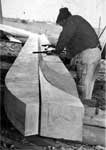
Backbone |

Stem Knee |
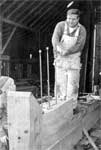
Keelson Bolts |
This old band mill was designed to saw 40’ logs but over the years, this prime timber was no longer available and it ran mostly 20’ and shorter stuff. The steam powered head rig stood about 20’ tall and was the first saw the logs went through as they were cut into ‘cants’. (Cants are large timbers from which smaller planks would be cut later in the process.) I remember sensing that it was a special moment for all concerned as they stopped operations long enough to install a huge, freshly sharpened band saw blade before they started on our logs. Today, we talk about a ½” or ¾” inch wide re-saw blade being the best for sawing lumber but that sucker was 6” wide. I remember watching Dad standing next to the sawyer on the head rig advising how he wanted the logs sawn. Slabs were cut off producing a flat side and then steam powered levers would flip the log for the next cut. It was a lively and amazing thing to watch these huge logs broken down and passed on to the smaller re-saw rig that produced the final planking and other timbers. (The reason for the two stage process is that the head rig takes about a ¼” kerf but the smaller re-saw rig only lost a little less than 1/8” for each pass. Much less waste and better yield with a smaller saw kerf.)
I got to work on the ‘green chain’ that afternoon, pulling the planks off into different piles based on the quality of the wood. The planks were long enough that they couldn’t fit properly across the ‘chain’ and had to be turned about 45 degrees to get them out of the back end of the mill. We hauled the lumber home to our ten acre farm and stacked it with stickers between the boards in our barn to air dry. When it was all done, we had a stack of 1½” x 12” x 33’ long, perfectly clear, (that means no knots or other blemishes), vertical grain, old growth, (annular growth rings about 14-15 per inch of diameter), planking. It was an amazing stack of lumber which ultimately yielded four boats. You can’t easily find wood like that today nor, if you could find some, afford it. I believe that pile of planking has contributed to my sinful tendency to ‘collect’ ‘good’ wood today.

Shaftlog Bolts |

Stem |

Bow Molds |
Dad also purchased enough green white oak that spring to frame the first boat. We cut it up and planed it to 1 7/8” x 2 5/8” stock and stacked it in the shade of the barn, well watered down with each layer interleaved with liberal amounts of rock salt and planer shavings and the whole pile wrapped in plastic and covered over with another layer of planer shavings to hold the moisture in through out the summer until we returned home in the fall from fishing. Dad also did some scrounging and managed to come up with a supply of 5/8” silicon bronze rod that was broken, cast off rollers from a local plywood mill. I think he spent all of $5 per length and they were about 10-12’ long. He also was able to lay his hands on a supply of 3/8” bronze fin-head bolts left surplus from the navy’s mine sweeper program. (A fin head bolt is like a flat headed carriage bolt with a wide flat cone shaped head with two small ‘fins’ that stuck down from the head along the shank of the bolt to keep it from turning in it’s hole as it was tightened.) I don’t think you could find these anywhere today. I still dream that somebody, somewhere still has the tooling to make them but I’m afraid it’s just a dream.
The next fall after we returned home from a summer of fishing, we started building what was to become the ‘Family Affair’. First of all was the process of lofting the lines for the boat. (Lofting is the process of drawing everything out full size so that patterns can be made from it.) We took careful measurements from the half hull model Dad had designed and scaled them up to full size drawings fairing out the inaccuracies due to the scaling up of the model. Our ‘loft floor’, where this drawing was done, was made when we knocked the inner wall dividing our woodshop and garage and built an extension to the floor out into the garage. Even doing that, we didn’t have enough floor to handle the full length of the design. We lofted it in two overlapping sections, one for the bow 2/3 and one for the stern 2/3. Not ideal but somehow dad made it work.
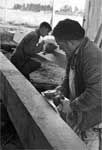
Dad & Dan working on keel sticks |
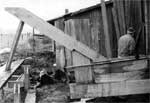
Horn timber |
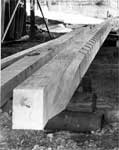
Keelson about done |
He ordered the keel and keelson ‘sticks’ that would be used to form the backbone of the hull and we started building the boat and we began to build the molds that would form the framework around which the hull would be built. (As a funny side note, we were never quite sure exactly how long one of our boats was going to be until we actually received the keel and keelson. These are not timbers that you can purchase at your local Lumbermen’s or Home Depot so you talk to the lumber companies starting with a sentence like “I’m looking for …” and you take what they can give you. Each of the hulls we built got longer in the order they were built.) The first keel was a 12”x6” timber about 35’ long if I remember correctly. Subsequent keels were 12” x 8”. The other main timber in the ‘backbone’ of a wooden boat is the keelson, a timber resting top of the keel. And they measured about 10” thick and 12-14” wide. Together we had about 22” of solid depth to the pair. Sturdy is the word that still comes to mind and this ‘backbone’ proved to be the very heart of a tough boat as I’ll tell you in another story some day.
Except for the three photos of Folly, the pictures with this story were taken during the building of our third hull, the ‘Endeavor’. I was working as a photographer at a local newspaper at the time and was able to get out to the farm and snap a few pictures periodically.
Paul Richmond
Port Orchard, Washington
USA

Other articles by Paul Richmond:
|